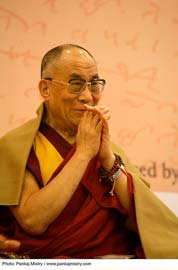Accommodation of Buddhism into Islam
As Manjushri Yashas did with Islam, Muslim authors of the period also explained Buddhism in terms that followers of their religion could understand. For example, at the beginning of the 8th century C.E., al-Kermani wrote a detailed account of Nava Vihara Monastery at Balkh in northern Afghanistan. In it, he described that Buddhists circumambulate and prostrate to a stone cube draped with cloth, as Muslims do at the Kaaba in Mecca. The cube referred to the platform in the center of the main temple on which a stupa stood. The Muslims, however, did not draw these similarities for the sake of using them as a device to lead Buddhists to the path of Islam. They gave Buddhists a simple choice: either keep their religion and pay an extra poll tax, or accept the truth of Islam and be exempt from the levy. Even when Muslim conquerors destroyed Buddhist monasteries as part of their invasion tactic to dispirit a population into surrender, they usually allowed their reconstruction so that they could exact a pilgrimage fee.
Conclusion
Several important questions remain. Is the Kalachakra portrait of conversion to Buddhism in the mythical land of Shambhala merely a description of what might have been beneficial and necessary in Afghanistan and the Indian subcontinent from the 9th to the 11th centuries C.E., or is it timeless advice? Granted the universal wisdom in members of all religions reaffirming the spiritual values of their creeds in order to ward off threats to their societies, is the optimal defense convincing as many people as possible to practice Buddhism? It would be difficult to defend this position, either in reference to only the above-mentioned historical period or as general advice, without being chauvinistic. The unbiased conclusion, then, is to admit that the tone of the Shambhala legend is indeed chauvinistic, although understandable, given the circumstances of the times. It does not follow, however, that Buddhist teachers nowadays need to be chauvinistic when presenting Buddhism to non-Buddhist audiences.
Peace among different societies comes from understanding each other's systems of beliefs. Educating others differs greatly from trying to convert them.
 When presenting Buddhism to non-Buddhist audiences, His Holiness the Fourteenth Dalai Lama always stresses that he is not trying to win converts. He is not challenging others to a debate contest, with the loser required to adopt the assertions of the victor. He explains that he is merely trying to educate others about Buddhism. Peace among different societies comes from understanding each other's systems of beliefs. Educating others differs greatly from trying to convert them. If others find something of value in Buddhism, they are free to adopt it, without any need to become Buddhists. For those who are strongly interested, they are welcome to pursue their studies further and even to become Buddhist, but only after a long period of deep reflection. For most, however, His Holiness strongly cautions against changing religions.
When presenting Buddhism to non-Buddhist audiences, His Holiness the Fourteenth Dalai Lama always stresses that he is not trying to win converts. He is not challenging others to a debate contest, with the loser required to adopt the assertions of the victor. He explains that he is merely trying to educate others about Buddhism. Peace among different societies comes from understanding each other's systems of beliefs. Educating others differs greatly from trying to convert them. If others find something of value in Buddhism, they are free to adopt it, without any need to become Buddhists. For those who are strongly interested, they are welcome to pursue their studies further and even to become Buddhist, but only after a long period of deep reflection. For most, however, His Holiness strongly cautions against changing religions.
Buddhism is no different from other religions or philosophical systems in that it claims to have the deepest truth. Nevertheless, the Buddhist assertion is not an exclusivist claim to the "One Truth." Buddhism also accepts relative truths -- things that are true relative to certain groups or to certain circumstances. So long as one's views are not aggressively antagonistic, one's relatively true beliefs may serve as provisional stepping-stones on the way to the deepest truth as Buddhism defines it. They may also serve as stepping-stones to the deepest truth that other religions teach. So long as the Buddhist assertion of deepest truth is not chauvinistic and does not belie a missionary policy, it may benefit those for whom it suits.
This article was first published by the Berzin Archives and is reprinted in a slightly condensed form with permission.
 Alexander Berzin received his Ph.D. from the Departments of Far Eastern Languages (Chinese) and Sanskrit and Indian Studies, Harvard University. For nearly thirty years, he resided primarily in Dharamsala, India, studying and practicing with masters from all four Tibetan Buddhist traditions. Since 1983, Berzin has been traveling around the world, teaching various aspects of Buddhist practice and philosophy, as well as Tibetan-Mongolian history and astro-medical theory, at Dharma centers and universities in more than seventy countries. He presently lives in Berlin, Germany, where he writes and manages www.berzinarchives.com.
Alexander Berzin received his Ph.D. from the Departments of Far Eastern Languages (Chinese) and Sanskrit and Indian Studies, Harvard University. For nearly thirty years, he resided primarily in Dharamsala, India, studying and practicing with masters from all four Tibetan Buddhist traditions. Since 1983, Berzin has been traveling around the world, teaching various aspects of Buddhist practice and philosophy, as well as Tibetan-Mongolian history and astro-medical theory, at Dharma centers and universities in more than seventy countries. He presently lives in Berlin, Germany, where he writes and manages www.berzinarchives.com.




